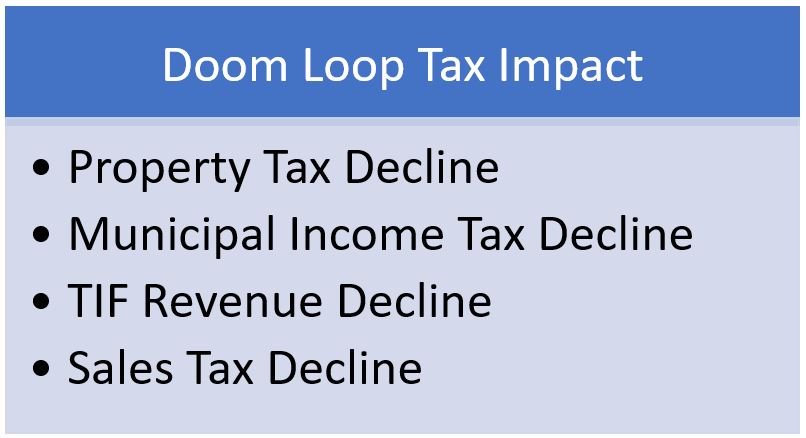Rising office vacancy rates are a reality as are dropping rents as office buildings compete for fewer and fewer customers. Local and state taxes connected to these buildings and workers will take a hit with the reduction in office values and loss of workers to Work From Home and Artificial Intelligence.
While it is too early to measure the loss in property taxes from this drop in value it will be substantial a recent New York City Comptroller report found that the estimated New York City property tax revenue shortfall relative to our current projections is $1.1 billion in FY 2027 but that constitutes only 3% of the total property tax levy, or 1.4% of City tax revenues, and 1.0% of total revenues, which include state and federal grants in the largest US office market. The Tax Policy Center found that the decline in office values is projected to cost D.C. $464 million in combined tax revenue over the next three fiscal years, and San Francisco could lose $150 to $200 million annually by 2028, about 5-6% of all current property taxes. The negative impact for states that permit cities to charge a municipal income tax for those that live or work in their city such as Ohio will be harmed even more by the high office vacancy rates in the Central Business District as they will lose out on a substantial amount of income tax they collected on workers who live in suburban communities but now no longer work in the big city. In addition, the decline in property tax values that will happen with high office vacancy rates will negatively impact the collection of Payments in Lieu of Taxes (PILOTs) that provide public infrastructure revenues for economic development projects or districts through Tax Increment Financing (TIF) agreements like Downtown Columbus that has a TIF District over the entire Downtown. Sales tax is another source of government funding that will be impacted by the high office vacancy rates as the lack of office workers has a direct impact on the decline of Downtown retail and restaurants.

This associated drop in local property tax, income tax, and TIF revenues will have some unknown impact on public services unless there is enough growth and development in other parts of the city to make up for the loss in a city’s Central Business District. With the number of suburban workers in Downtown office towers it is doubtful that the revenue in other parts of the city will make up for the loss in Downtown revenue. The loss in local tax revenue and the decline of public services will impact the overall quality of life in the community. Parks, public infrastructure, police, and fire services all cost money and the Downtown which has been “cash cows” for decades for local governments and school districts will shift in their tax status—and not in a good way for Downtown neighborhoods.
High office vacancy rates spell trouble for corporate site location projects that are heavy office users like advanced services, corporate headquarters and professional service firms as these projects are not producing jobs in an office that are critical for the collection of local and state economic development incentives. Local and state government economic development incentives are driven by a Return on Investment (ROI) analysis that determines if a company will create more taxes than they take from economic development incentives.
2024 will not be a winning year for corporate site location projects tied to major office expansions, but hopefully this creates opportunities for communities to transform these distressed office building into new and better uses.